Multi-Criteria Methodology for the Location of Photovoltaic Solar Energy Production Facilities in Tenerife (Spain)
Abstract
:1. Introduction
2. Materials and Methods
2.1. Aptitude Model
- -
- Physical Environment Variables:
- (1)
- (2)
- Solar irradiation, so that the maximum levels of the Horizontal Global Irradiation (HGI) variable provide maximum levels of suitability with respect to this criterion of degree of sunshine [48]; and
- (3)
- Cloudiness, the extent and thickness of the cloud cover has a very negative effect on the surface incidence of direct solar radiation and increases the proportion of diffuse radiation [49]. Although for our area of study it is not necessary, in territories with a greater Saharan influence it would be interesting to add the variable atmospheric dust from the Sahara to the model, because of its negative influence on the performance of solar panels [50,51,52].
- -
- Development Pattern Variables:
- (1)
- Communication routes, considering that greater accessibility to these routes implies greater suitability; and
- (2)
- Connection to electrical energy networks, the greater the proximity to a medium voltage electrical line, the greater the suitability of this location for the location of a photovoltaic solar energy installation.
2.2. Impact Model
- (1)
- Hydrology (greater impact according to shorter distance from the riverbeds);
- (2)
- Land uses (Land uses of the Corine Land Cover 2012 and Map of Crops of the Canary Islands); and
- (3)
- Landscape vulnerability (with two sub-variables:
- (a)
- Proximity and
- (b)
- Cumulative visibility), establishing that the maximum impact values coincide both with the values of maximum visibility from the centroids of the towns, and with the values of greater proximity to the centroids of the towns and roads.
2.3. Hosting Capacity Model
2.4. Selection of Municipalities and Regions
3. Results
3.1. Aptitude Model
3.2. Impact Model
3.3. Hosting Capacity Model
3.4. Restrictions
3.5. Optimal Municipalities and Districts
4. Discussion
5. Conclusions
Author Contributions
Funding
Data Availability Statement
Conflicts of Interest
References
- Orbegozo, C.; Arivilca, R. Energía Solar Fotovoltaica. Manual Técnico para Instalaciones Domiciliarias; Green Energy Consultoría y Servicios: Lima, Peru, 2010. [Google Scholar]
- Cabildo Insular de Tenerife. Revisión del Programa de Actuación del Plan Insular de Ordenación de Tenerife. Documento de Aprobación Definitiva. 2011. Available online: https://www.tenerife.es/planes/PTEOTrenNorte/adjuntos/MemoInfo_01.pdf (accessed on 10 January 2022).
- Gobierno de España. Ley 24/2013, de 26 de diciembre, del Sector Eléctrico (LSE). Boletín Of. Estado 2013, 310, 105198–105294. [Google Scholar]
- Gobierno de España. Real Decreto 413/2014, de 6 de junio, por el que se regula la actividad de producción de energía eléctrica a partir de fuentes de energía renovables, cogeneración y residuos. Boletín Of. Estado 2014, 140–186. [Google Scholar]
- Huacuz, J.M.; Villaseñor, F.; Urrutia, M. Photovoltaicrural Electrification and the Electric Power Utility; Cocoyoc. In Proceedings of the Photovoltaic Rural Electrification and the Electric Power Utility, Cocoyoc, Mexico, 8–12 May 1995. [Google Scholar]
- Hochmuth, F. Assessment of Photovoltaic Battery Charging Stations to Provide Basic Electricity Services for Remote Rural Households; DME: Arcadia, South Africa, 1997. [Google Scholar]
- Gonçalves Pereira, A. Cuatrecasas. Nota Monográfica/Energía: Real Decreto 413/2014, que Regula la Actividad de Producción de Energía Eléctrica a Partir de Fuentes de Energía Renovables, Cogeneración y Residuos. 2014. Available online: https://www.boe.es/diario_boe/txt.php?id=BOE-A-2014-6123 (accessed on 10 January 2022).
- Rodríguez-Borges, C.G.; Sarmiento-Sera, A. Sizing through simulation of systems for photovoltaic solar energy applied to rural electrification. Ing. Mecánica 2011, 14, 13–21. [Google Scholar]
- Instituto para la Diversificación y Ahorro de la Energía—IDAE. Instalaciones de Energía Solar Fotovoltaica. Pliego de Condiciones Técnicas de Instalaciones Conectadas a Red. (PTC-C-Revisión Julio 2011); IDAE: Madrid, Spain, 2011. [Google Scholar]
- López Díaz, A.I.; Blanco Silva, F. Instalaciones de Energía Solar Fotovoltaica. Servicio de Publicaciones; Universidad Católica de Ávila, UCAV: Avilla, Spain, 2012. [Google Scholar]
- Perpiñán Lamigueiro, O. Enaergía Solar Fotovoltaica. 2015. Available online: https://github.com/oscarperpinan/esf (accessed on 10 January 2022).
- Gholami, Y.; Gholami, A.; Ameri, M.; Zandi, M. Investigation of applied methods of using passive energy in iranian traditional urban design case study of Kashan. In Proceedings of the 4th International Conference on Advances in Mechanical Engineering, Istanbul, Turkey, 19–21 December 2018; pp. 3–12. [Google Scholar]
- Guidi, D. A Model for the Evaluation of Sustainable Development Investments: The Case Ofrural Electrification in Morocco. Ph.D. Thesis, Department of Agricultural Economics and Policy, University of Siena, Siena, Italy, 1997. [Google Scholar]
- Van Campen, B.; Guidi, D.; Best, G. Energía Solar Fotovoltaica para la Agricultura y el Desarrollo Sostenible. Documento de Trabajo sobre Medio Ambiente y Recursos Naturales n° 3; FAO: Rome, Italy, 2000. [Google Scholar]
- Agencia Europea de Medio Ambiente—European Environment Agency. Renewable Energy in Europe—2017 Update Recent Growth and Knock-On Effects; EEA Report No. 23/2017; European Environment Agency: Luxembourg, 2017.
- Pillai, U. Drivers of cost reduction in solar photovoltaics. Energy Econ. 2015, 50, 286–293. [Google Scholar] [CrossRef]
- Strupeit, L.; Neij, L. Cost dynamics in the deployment of photovoltaics: Insights from the German market for building-sited systems. Renew. Sustain. Energy Rev. 2017, 69, 948–960. [Google Scholar] [CrossRef]
- Akrami, E.; Gholami, A.; Ameri, M.; Zandi, M. Integrated an innovative energy system assessment by assisting solar energy for day and night time power generation: Exergetic and Exergo-economic investigation. Energy Convers. Manag. 2018, 175, 21–32. [Google Scholar] [CrossRef]
- Eslami, S.; Gholami, A.; Bakhtiari, A.; Zandi, M.; Noorollahi, Y. Experimental investigation of a multi-generation energy system for a nearly zero-energy park: A solution toward sustainable future. Energy Convers. Manag. 2019, 200, 112107. [Google Scholar] [CrossRef]
- Gobierno de España. Real Decreto-ley 23/2020, de 23 de junio, por el que se aprueban medidas en materia de energía y en otros ámbitos para la reactivación económica. Boletín Of. Estado 2020, 175–223. [Google Scholar]
- Lüthi, S.; Wüstenhagen, R. The price of policy risk—Empirical insights from choice experiments with European photovoltaic project developers. Energy Econ. 2012, 34, 1001–1011. [Google Scholar] [CrossRef] [Green Version]
- Espejo, C. La energía solar fotovoltaica en España. Nimbus 2004, 13–14, 5–31. [Google Scholar]
- Hadjipanayi, M.; Koumparou, I.; Philippou, N.; Paraskeva, V.; Phinikarides, A.; Makrides, G.; Efthymiou, V.; Georghiou, G.E. Prospects of photovoltaics in southern European, Mediterranean and Middle East regions. Renew. Energy 2016, 92, 58–74. [Google Scholar] [CrossRef]
- Torres, C.J.; Cuevas, E.; Guerra, J.C.; Carreño, V. Caracterización de las masas de aire en la región subtropical sobre Canarias. In Proceedings of the V Simposio Nacional de Predicción, INM, Madrid, Spain, 20–23 November 2001. [Google Scholar]
- Sancho Ávila, J.M.; Riesco Martín, J.; Jiménez Alonso, C.; Sánchez de Cos Escuin, M.C.; Montero Cadalso, J.; López Bartolomé, M. Atlas de Radiación Solar en España Utilizando Datos del SAF de Clima de EUMETSAT; Gobierno de España: Madrid, Spain, 2012. [Google Scholar]
- Castañer, L. Energía solar fotovoltaica. Investig. Cienc. 1981, 56, 6–15. [Google Scholar]
- Capel Molina, J.J. El Clima de la Península Ibérica; Ariel: Barcelona, Spain, 2000; 281p. [Google Scholar]
- Gobierno de Canarias. Consejería de Economía, Industria, Comercio y Conocimiento. Anuario Energético de Canarias 2015; Gobierno de Canarias: Santa Cruz de Tenerife, Spain, 2016. [Google Scholar]
- Dorta, P. La inversión térmica en Canarias. Investig. Geográficas 1985, 115, 109–126. [Google Scholar]
- Marzol Jaén, M.V.; Máyer Suárez, P. Algunas reflexiones acerca del clima de las Islas Canarias. Nimbus 2012, 29–30, 399–416. [Google Scholar]
- Fundación CIEC. Caracterización Climática de las Islas Canarias para la Aplicación del Código Técnico de Edificación CLIMCAN-010 y su Aplicación Informática; Ministerio de Fomento, Gobierno de España: Madrid, Spain, 2013. [Google Scholar]
- Gobierno de Canarias; Consejería de Industria, Comercio y Nuevas Tecnologías; Viceconsejería de Industria y Nuevas Tecnologías; Dirección General de Industria. Guía Técnica de Aplicación para Instalaciones de Energías Renovables: Instalaciones Fotovoltaicas. Available online: http://www.agenergia.org/wp-content/uploads/2018/05/1234263307_GuiaFotovoltaicaGobCan.pdf (accessed on 10 January 2022).
- Antón, M.; Gil, J.E.; Fernández-Gálvez, J.; Lyamani, H.; Valenzuela, A.; Foyo Moreno, I.; Olmo, F.J.; Alados-Arboledas, L. Evaluation of the aerosol forcing efficiency in the UV erythemal range at Granada, Spain. J. Geophys. Res. Atmos. 2011, 116, D20214. [Google Scholar] [CrossRef]
- Cabildo Insular de Tenerife. Plan Insular de Ordenación de Tenerife. Documento de Aprobación Definitiva. 2002. Available online: http://www.gobiernodecanarias.org/boc/2002/140/boc-2002-140-001.pdf (accessed on 10 January 2022).
- Cabildo Insular de Tenerife. Criterios Generales de Implantación Territorial de las Plantas Fotovoltaicas Aprobados por Acuerdo del Consejo de Gobierno Insular en Sesión Ordinaria Celebrada el 12 de Noviembre de 2007. S/C Tenerife. 2007. Available online: http://www.conama11.vsf.es/conama10/download/files/conama2018/CT%202018/222224176.pdf (accessed on 10 January 2022).
- Gobierno de Canarias. Consejería de Industria, Comercio y Nuevas Tecnologías. Directrices de Ordenación Sectorial de Energía. Documento de Aprobación Inicial. 2013. Available online: https://www.boe.es/buscar/act.php?id=BOE-A-2003-13621 (accessed on 10 January 2022).
- Gobierno de España. Orden IET/1953/2015, de 24 de septiembre, por la que se modifica la Orden IET/1459/2014, de 1 de agosto, por la que se aprueban los parámetros retributivos y se establece el mecanismo de asignación del régimen retributivo específico para nuevas instalaciones eólicas y fotovoltaicas en los sistemas eléctricos de los territorios no peninsulares. Boletín Of. Estado 2015, 232, 86952–86956. [Google Scholar]
- Sánchez-Lozano, J.M.; García-Cascales, M.S.; Lamata, M.T. Evaluación de ubicaciones adecuadas para la instalación de plantas de energía solar termoeléctrica. Comput. Ing. Ind. 2015, 87, 343–355. [Google Scholar] [CrossRef]
- Marques-Perez, I.; Guaita-Pradas, I.; Gallego, A.; Segura, B. Territorial planning for photovoltaic power plants using an outranking approach and GIS. J. Clean. Prod. 2020, 257, 120602. [Google Scholar] [CrossRef]
- Santos Preciado, J.M. El planteamiento teórico multiobjetivo/multicriterio y su aplicación a la resolución de problemas medioambientales y territoriales, mediante los S.I.G. Ráster. Espac. Tiempo Forma Ser. VI Geogr. 1997, 10, 129–151. [Google Scholar] [CrossRef]
- Galacho Jiménez, F.B.; Arrebola Castaño, J.A. Modelo de evaluación de la capacidad de acogida del territorio con SIG y técnicas de decisión multicriterio respecto a la implantación de edificaciones en espacios rurales. Investig. Geográficas 2013, 60, 69–85. [Google Scholar] [CrossRef] [Green Version]
- Velázquez Saornil, J.; Hernando Gallego, A.; Arroyo Méndez, L.A.; Chasco Yrigoyen, C.; Díaz Gutiérrez, V.; García Angulo, C.; Gutiérrez Velayos, J.; Mongil Manso, J.; Rincón Herráez, V.; Sánchez Reyes, B. Aplicaciones de los Sistemas de Información Geográfica y la Teledetección a la Gestión Ambiental. Ejercicios con software libre. Phytoma España Rev. Prof. Sanid. Veg. 2017, 294, 27–30. [Google Scholar]
- Aguiló Pastrana, M.L. Metodología para la localización óptima de instalaciones de energía solar fotovoltaica en la isla de Tenerife, España. In Proceedings of the 2018 Congreso Nacional del Medio Ambiente, Madrid, Spain, 26–29 November 2018. [Google Scholar]
- Kazem, H.A.; Chaichan, M.T. Effect of environmental variables on photovoltaic performance-based on experimental studies. Int. J. Civ. Mech. Energy Sci. 2016, 2, 1–8. [Google Scholar]
- García Rodríguez, J.L.; Giménez Suárez, M.C. Aplicación de algoritmos matemáticos en la determinación de la inclinación de pendiente en un entorno SIG. Aqua-LAC 2010, 2, 78–82. [Google Scholar]
- Abdolzadeh, M.; Mehrabian, M.A. Obtaining maximum input heat gain on a solar collector under optimum slope angle. Int. J. Sustain. Energy 2011, 30, 353–366. [Google Scholar] [CrossRef]
- Kim, B.; Han, S.; Heo, J.; Jung, J. Proof-of-concept of a two-stage approach for selecting suitable slopes on a highway network for solar photovoltaic systems: A case study in South Korea. Renew. Energy 2020, 151, 366–377. [Google Scholar] [CrossRef]
- Kaushik, S.C.; Rawat, R.; Manikandan, S. An innovative thermodynamic model for performance evaluation of photovoltaic systems: Effect of wind speed and cell temperature. Energy Convers. Manag. 2017, 136, 152–160. [Google Scholar] [CrossRef]
- Urrejola, E.; Antonanzas, J.; Ayala, P.; Salgado, M.; Ramírez-Sagner, G.; Cortés, C.; Pino, A.; Escobar, R. Effect of soiling and sunlight exposure on the performance ratio of photovoltaic technologies in Santiago Chile. Energy Convers. Manag. 2016, 114, 338–347. [Google Scholar] [CrossRef]
- Rezazadeh, M.; Irannejad, P.; Shao, Y. Climatology of the Middle East dust events. Aeolian Res. 2013, 10, 103–109. [Google Scholar] [CrossRef]
- Saidan, M.; Albaali, A.G.; Alasis, E.; Kaldellis, J.K. Experimental study on the effect of dust deposition on solar photovoltaic panels in desert environment. Renew. Energy 2016, 92, 499–505. [Google Scholar] [CrossRef]
- Gholami, A.; Ameri, M.; Zandi, M.; Ghoachani, R.G.; Eslami, S.; Pierfederici, S. Photovoltaic Potential Assessment and Dust Impacts on Photovoltaic Systems in Iran: Review Paper. IEEE J. Photovolt. 2020, 10, 824–837. [Google Scholar] [CrossRef]
- Cabildo Insular de Tenerife; Consejo Insular de Aguas de Tenerife. Plan Hidrológico de Tenerife. Documento de Aprobación Definitiva. Cabildo Insular de Tenerife: Santa Cruz de Tenerife, Spain, 2015. [Google Scholar]
- Gobierno de Canarias. Decreto-Legislativo 1/2000, de 8 de mayo, por el que se aprueba el Texto Refundido de las Leyes de Ordenación del Territorio de Canarias y de Espacios Naturales de Canarias. Boletín Of. Canar 2000, 60, 5989–6307. [Google Scholar]
- Gobierno de España. Ley 4/2017, de 13 de julio, del Suelo y de los Espacios Naturales Protegidos de Canarias. Boletín Of. Estado 2017, 216, 88273–88515. [Google Scholar]
- Monedero, J.; García, J.; Dobon, F.; Yanes, M.A.; Hernandez, F. Calculation of the PV Potential Maps in the Canary Island. In Proceedings of the 22nd European Photovoltaic Solar Energy Conference and Exhibition, Milan, Italy, 3–7 September 2007. [Google Scholar]
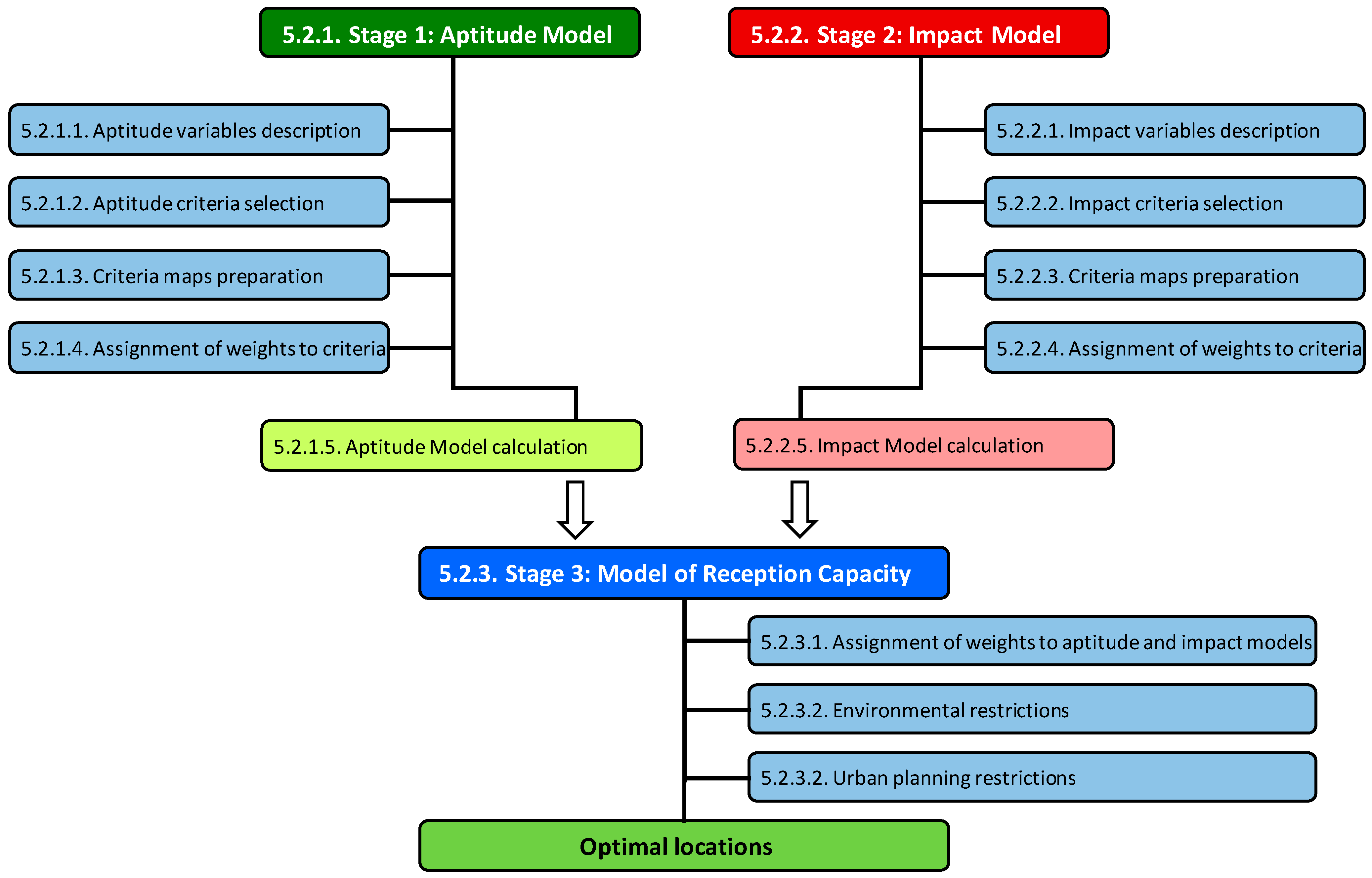
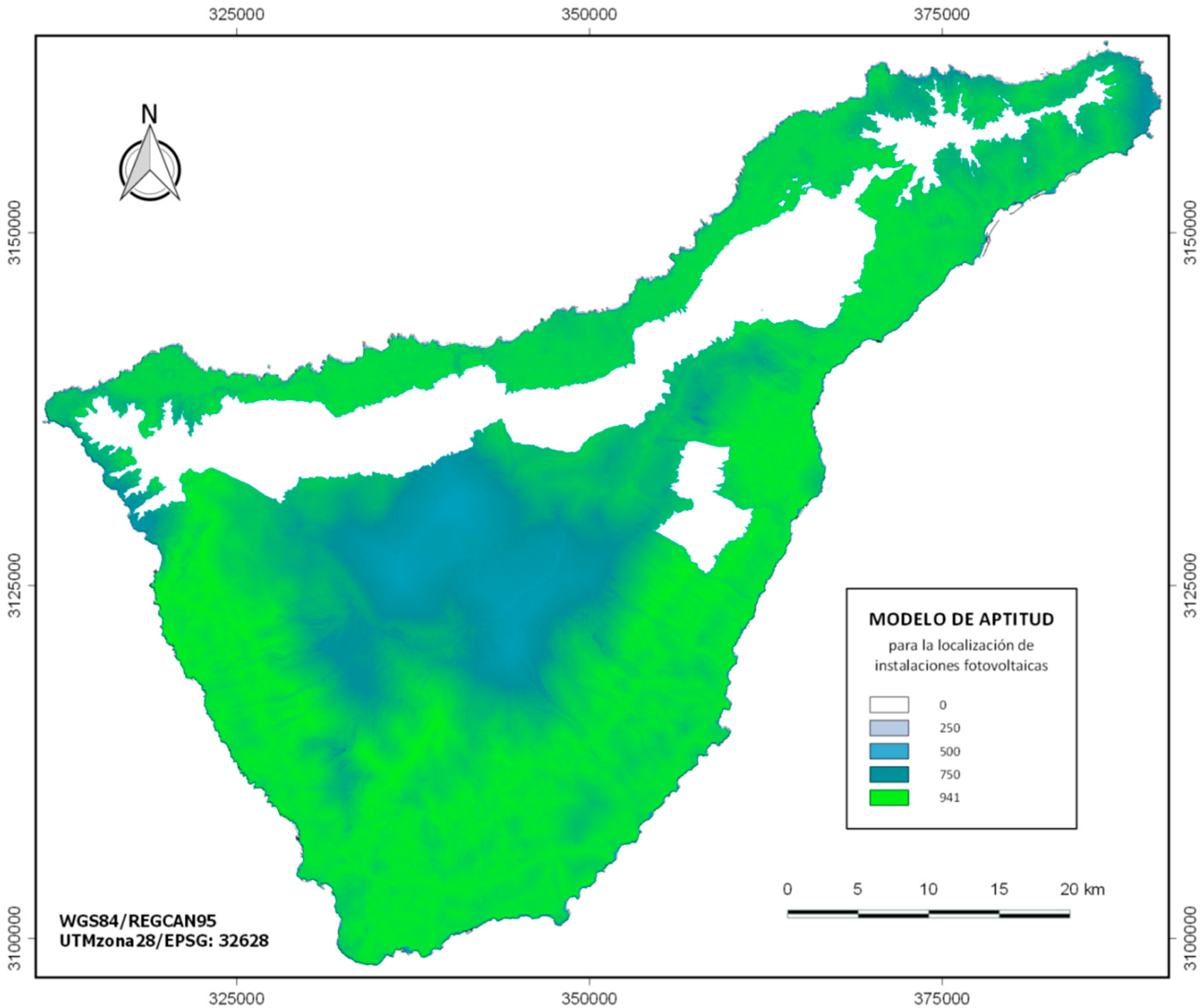
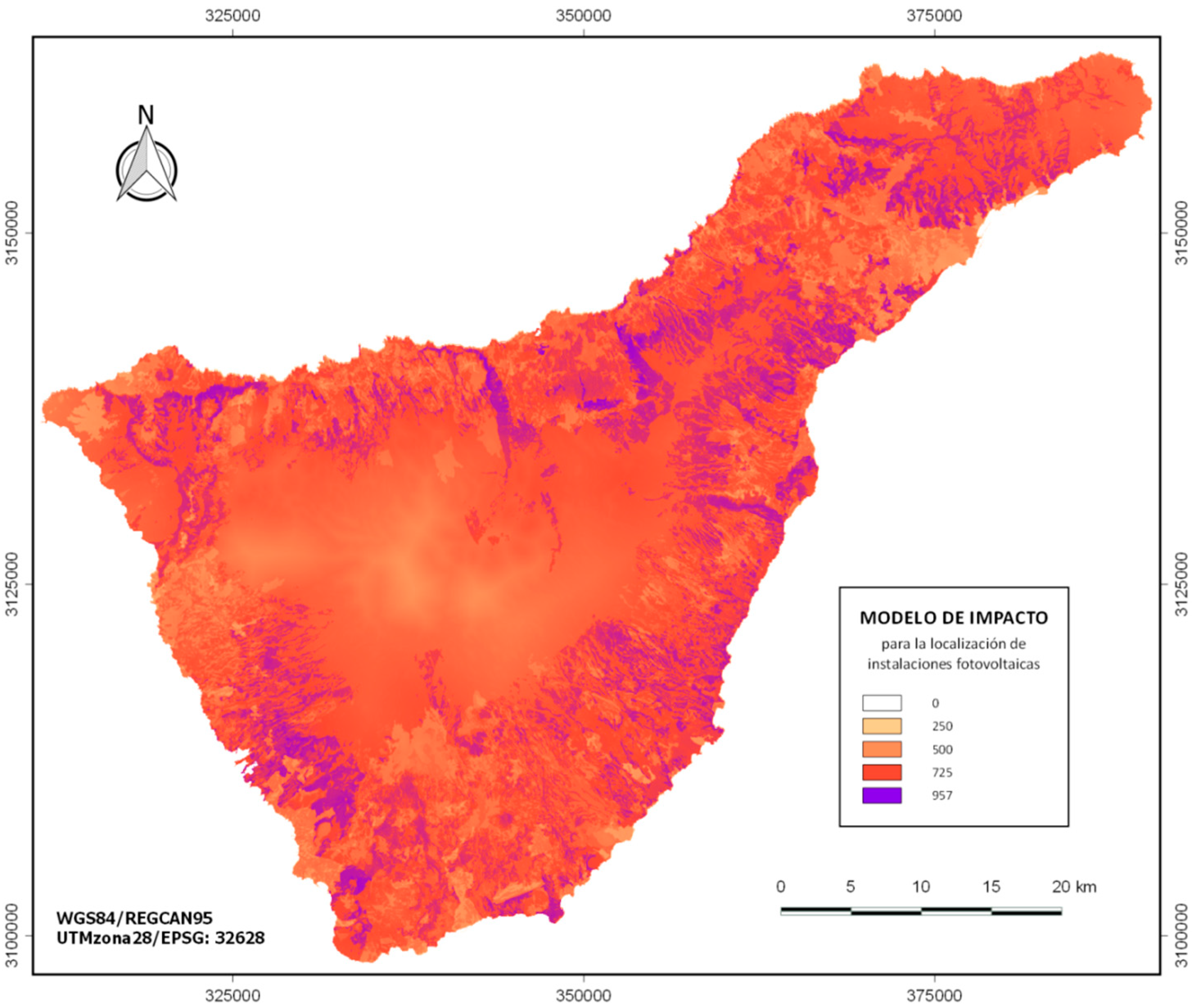
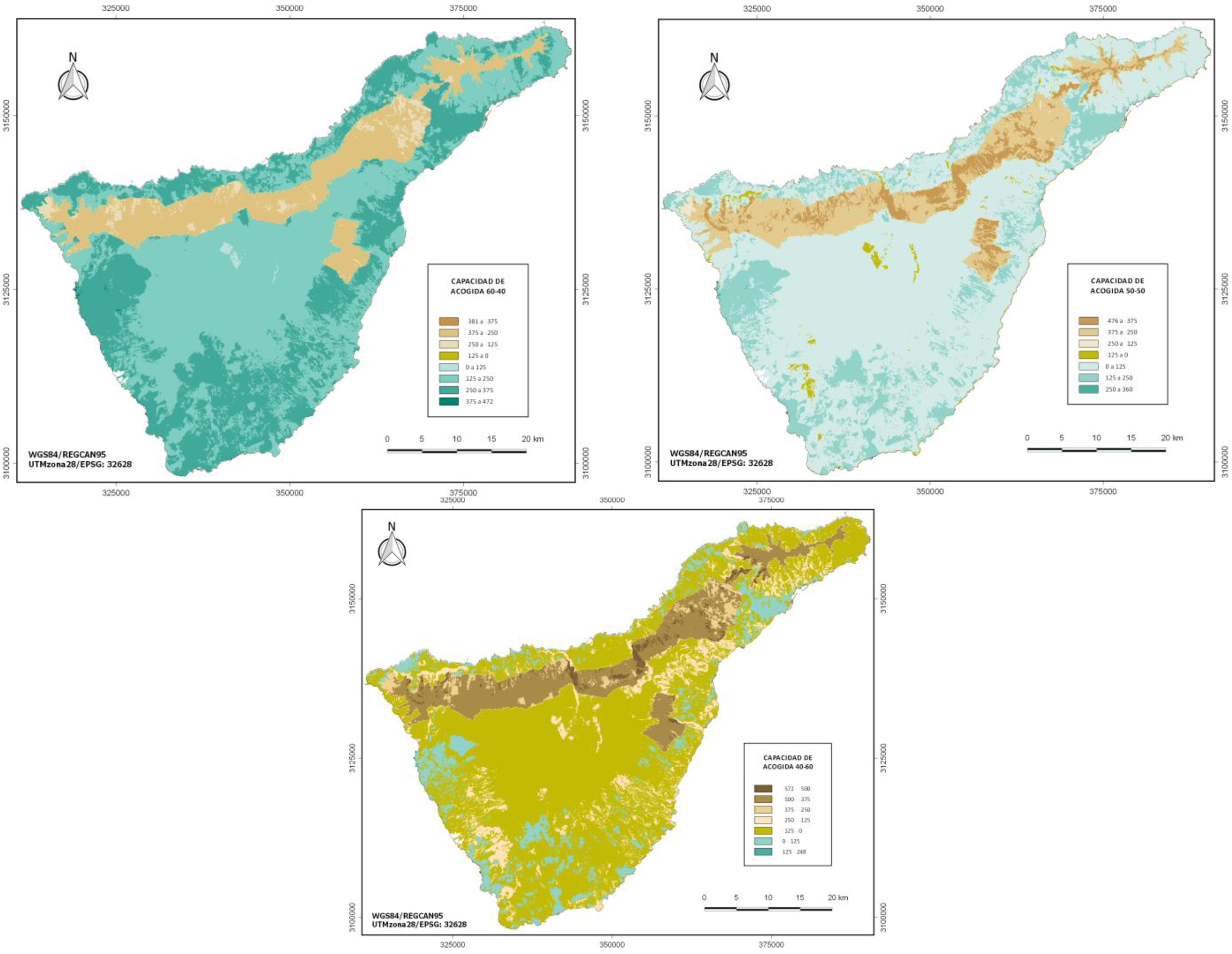
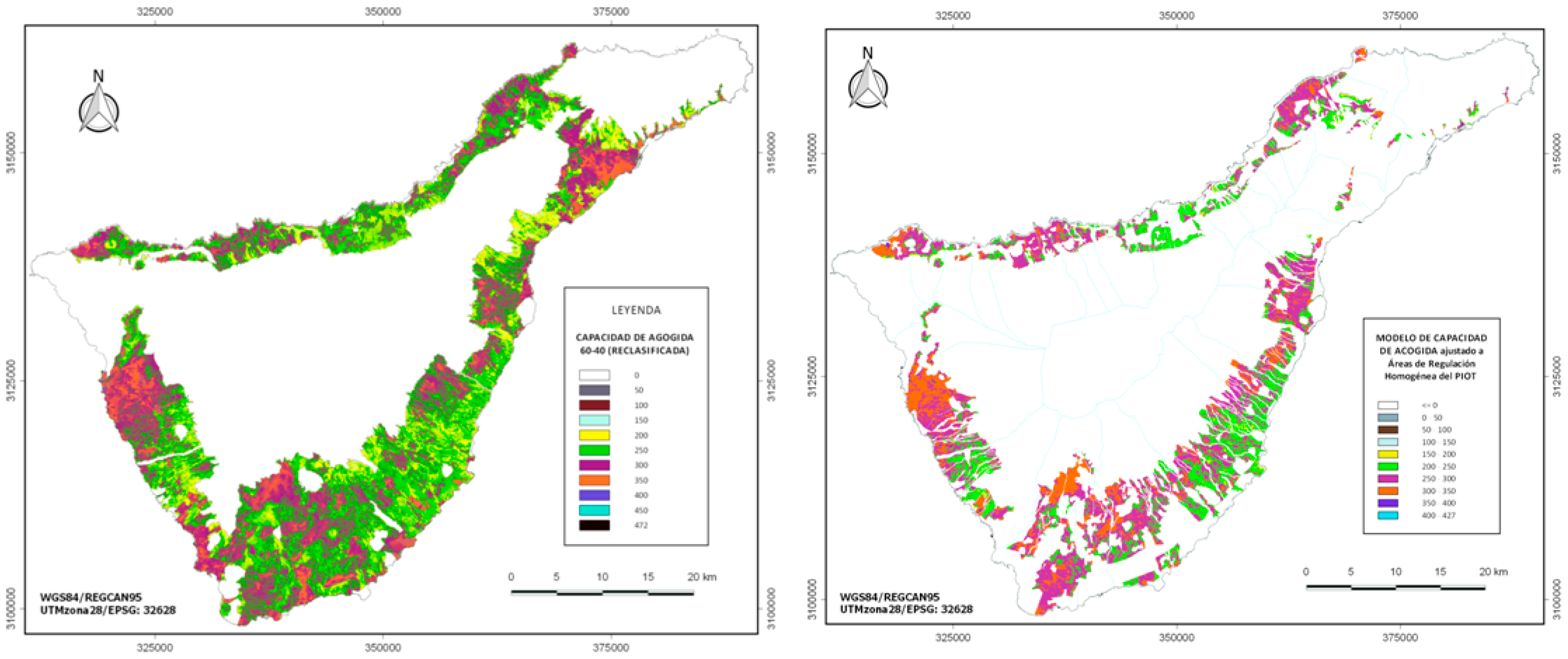
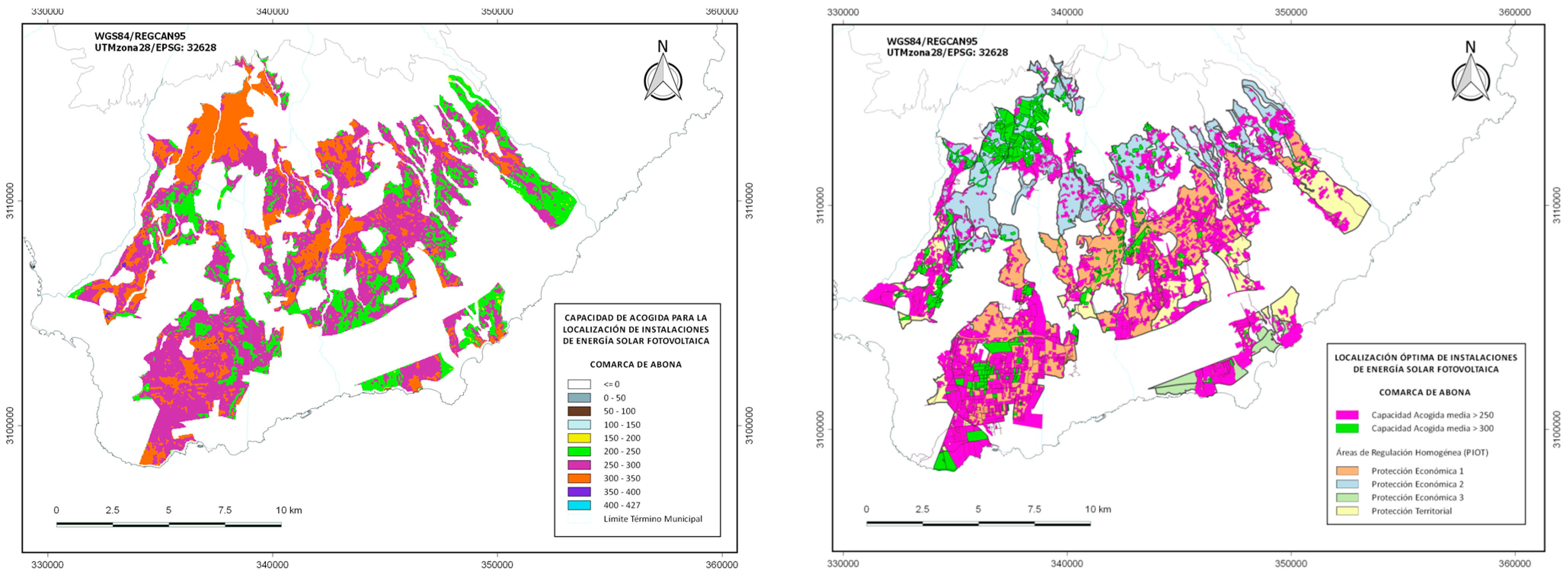

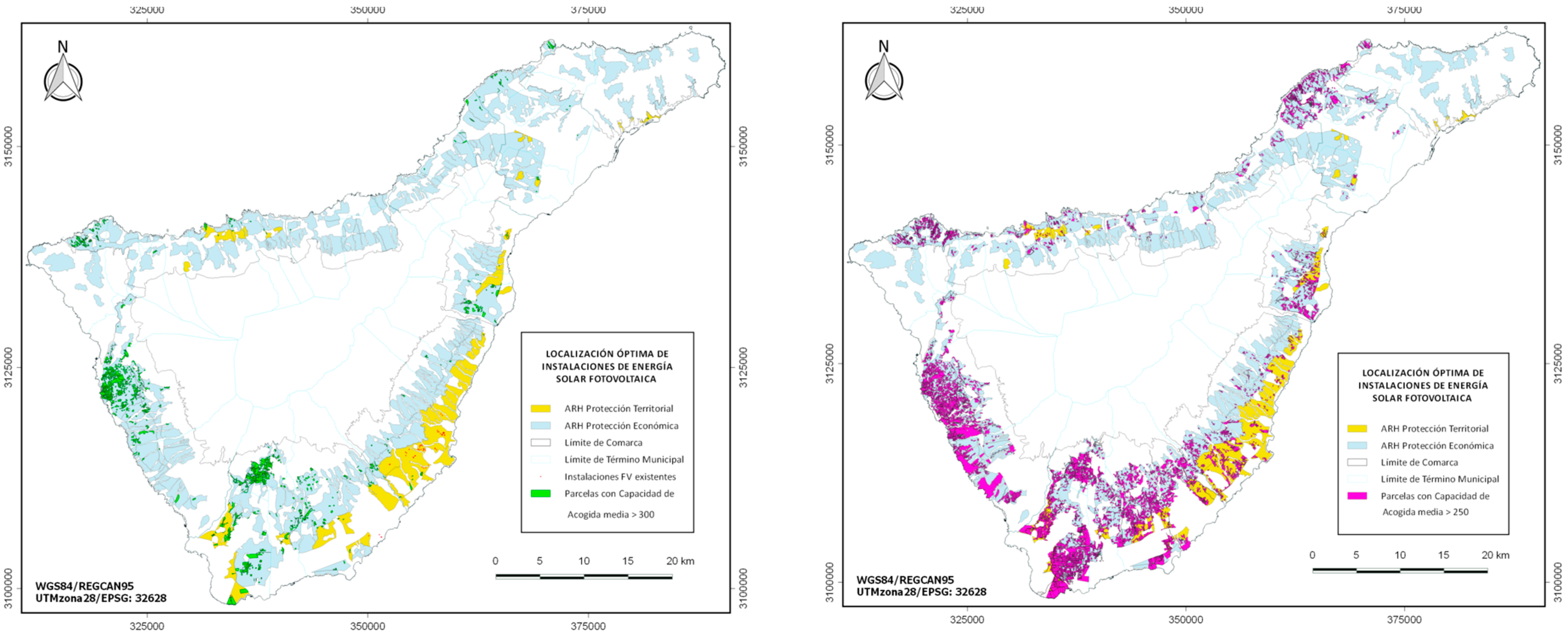
| Expert 1 | Expert 2 | Expert 3 | Expert 4 | Average Weights | |
|---|---|---|---|---|---|
| Insolation | 0.327 | 0.448 | 0.310 | 0.365 | 0.363 |
| Power lines | 0.191 | 0.239 | 0.310 | 0.320 | 0.265 |
| Slope | 0.327 | 0.216 | 0.259 | 0.087 | 0.222 |
| Roads | 0.155 | 0.097 | 0.121 | 0.228 | 0.150 |
| Expert 1 | Expert 2 | Expert 3 | Expert 4 | Average Weights | |
|---|---|---|---|---|---|
| Hydrology | 0.072 | 0.103 | 0.162 | 0.231 | 0.142 |
| Vulnerability | 0.589 | 0.605 | 0.529 | 0.215 | 0.485 |
| Land uses | 0.339 | 0.292 | 0.309 | 0.554 | 0.373 |
| ABONA Region | Cadastral Plots | Plots Surface >10.000 m2 | Plots Slope < 25% | Plots with Average RC Value > 250 | Plots with Average RC Value > 300 | Average RC Value (V Maximum) |
|---|---|---|---|---|---|---|
| Granadilla | 15.512 | 2.793 | 2041 | 908 | 91 | 324.25 |
| San Miguel de Abona | 7.938 | 638 | 457 | 234 | 42 | 331.23 |
| Arona | 10.724 | 1.219 | 1.036 | 730 | 110 | 354.36 |
| Vilaflor | 6.154 | 815 | 461 | 266 | 181 | 340.14 |
Publisher’s Note: MDPI stays neutral with regard to jurisdictional claims in published maps and institutional affiliations. |
© 2022 by the authors. Licensee MDPI, Basel, Switzerland. This article is an open access article distributed under the terms and conditions of the Creative Commons Attribution (CC BY) license (https://creativecommons.org/licenses/by/4.0/).
Share and Cite
Gutiérrez, J.; Velázquez, J.; Aguiló, M.L.; Herráez, F.; Jiménez, C.; Canelo, L.E.; Hernando, A.; Gómez, I.; Rincón, V. Multi-Criteria Methodology for the Location of Photovoltaic Solar Energy Production Facilities in Tenerife (Spain). Infrastructures 2022, 7, 28. https://doi.org/10.3390/infrastructures7030028
Gutiérrez J, Velázquez J, Aguiló ML, Herráez F, Jiménez C, Canelo LE, Hernando A, Gómez I, Rincón V. Multi-Criteria Methodology for the Location of Photovoltaic Solar Energy Production Facilities in Tenerife (Spain). Infrastructures. 2022; 7(3):28. https://doi.org/10.3390/infrastructures7030028
Chicago/Turabian StyleGutiérrez, Javier, Javier Velázquez, María Luz Aguiló, Fernando Herráez, Carlos Jiménez, Luis Eduardo Canelo, Ana Hernando, Inmaculada Gómez, and Víctor Rincón. 2022. "Multi-Criteria Methodology for the Location of Photovoltaic Solar Energy Production Facilities in Tenerife (Spain)" Infrastructures 7, no. 3: 28. https://doi.org/10.3390/infrastructures7030028
APA StyleGutiérrez, J., Velázquez, J., Aguiló, M. L., Herráez, F., Jiménez, C., Canelo, L. E., Hernando, A., Gómez, I., & Rincón, V. (2022). Multi-Criteria Methodology for the Location of Photovoltaic Solar Energy Production Facilities in Tenerife (Spain). Infrastructures, 7(3), 28. https://doi.org/10.3390/infrastructures7030028










